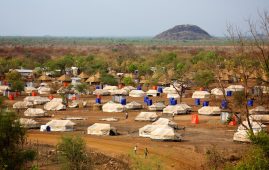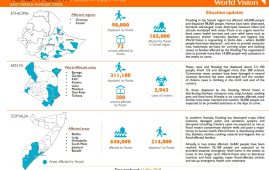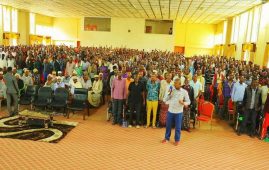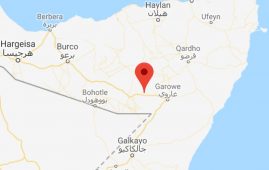It is fashionable for detractors of Ethiopia to claim that ‘Zenawi invaded Somalia at the behest of George Bush’, as Ana Gomez, Portuguese member of EU parliament, said recently.
Leaked Cables, however, show a parade of US political and army officials expressing skepticism to, at times advising against, the military option, while the Ethiopians feared US and EU might publicly condemn the military intervention.
Contrary to the revelations in the Cables, the myth that United States ordered and financed the Dec. 2006 Ethiopia’s military intervention in Somalia continues to be one of the few things that not a few analysts and media outlets of Western/industrialized countries agree with their counterparts in the Gulf states.
It might look commonsensical to suppose an African country wouldn’t articulate, and act upon, her own foreign policy objectives. But that is not all.
The ‘invasion’
Actually, the Ethiopian military mission was not against Somalia. As far as the United Nations and most members of the international community are concerned the legitimate government of Somalia is the Transitional Federal Government (TFG), which was established in 2004 in Eldoret, Kenya, after a protracted negotiations among representatives of Somali clans, sub-clans and the civil society, including the Somali diaspora.
the Transitional Federal Government (TFG), which was established in 2004 in Eldoret, Kenya, after a protracted negotiations among representatives of Somali clans, sub-clans and the civil society, including the Somali diaspora.
And, that government of Somalia – the TFG – requested Ethiopian military intervention and also approved in advance virtually all major undertakings.
Of course, the TFG didn’t have effective control of all the territories belonging to the republic of Somalia, though it had a firm legal status as the only legitimate authority. The northern half has long proclaimed itself a Republic of Somaliand. Next to her is Puntland, a self-proclaimed autonomous region, which ascribes to the TFG as its federal state. Both Somaliland and Puntland have intimate relations with the Ethiopian government. The rest of the central and southern Somalia was controlled by various warlords. The seat of the TFG was in Baidoa city, while an opposition alliance, consisting of warlords, dissident TFG Ministers, certain businessmen, occupied the capital city, Mogadishu.
By mid-2006, a new player emerged – the Union of Islamic Courts (UIC), also known as Council of Islamic Courts (CIC). By June that year, the UIC was already in control of most parts of Mogadishu and southern Somalia. UIC/CIC soon started advancing on the strongholds of the TFG. According to TFG Prime Minister Gedi, UIC had issued an assassination list against him and several other TFG leaders.
UIC’s progress was indeed alarming – as former leaders and operatives of Al-Itihaad al-Islamiya, such as Sheikh Aweys and Hassan Al-Turki, held key places in its leadership. In fact, UIC leaders proclaimed a ‘Jihad’ on Ethiopia – to annex the Somali speaking territories of Ethiopia. Further, a UN Security Council report confirmed the presence two Ethiopian insurgent groups among UIC fighters and its link to half a dozen countries, inc. Iran, Libya, Syria, Saudi Arabia,Egypt, and, of course, Eritrea.
The second half of 2006 passed with UIC declaring cease-fire one month and attacking TFG bases the next month. The Horn of Africa’s grouping, IGAD, and its member countries tried in vain to negotiate the UIC and TFG. A proposal to send peace keeping mission IGASOM (IGAD-Somalia) that consists and/or accompanied by Ugandan troops couldn’t get UN blessing until December, while the issue of was not touched yet.
Ethiopia also held several secret talks with UIC leaders from June to Dec, while dozens of ENDF officers were stationed in Baidoa (as military advisors or force protection or training teams or whatever they call them).
By December 24, however, about a month after the Ethiopian parliament authorized ‘all necessary measures’ to to thwart the ‘clear and present danger’ posed by the UIC and following a request by the TFG parliament, the Ethiopian National Defense Forces (ENDF) attacked UIC bases inside Somalia. Former US Ambassador Yamamoto estimated, weeks prior to the offensive, that:
‘ENDF assets currently positioned near southern Somalia suggest an attack prosecuted by roughly 10,000 ENDF troops, 36 artillery pieces and 40-50 T-54/55 tanks. The ENDF will likely support the TFG militia numbering 8,000-10,000 as well as Puntland defense forces numbering 3-4,000.’
In less than 72 hours, ENDF troops and TFG-allied fighters captured some 21 cities.
By Dec. 27 the UIC collapsed, as its extremist members reportedly fled from Mogadishu via boat to a port on the Southern edge of Somalia. Yet, ENDF troops paused 20 kilometers from Mogadishu, where they met Somali clan elders who ‘requested that the ENDF enter Mogadishu, as looting and fighting was going out of control’ in the city.
The original purpose of the mission – reversing UIC’s momentum – had already been achieved. But with the collapse of UIC abandoning Mogadishu and its major bases, the Ethiopian government saw an opportunity to help the TFG stand on its feet, as well as prevent chaos in Mogadishu. An illusive objective that extended the mission by two years.
A number of question could be raised on the Ethiopian intervention and stay in Somalia. Was it necessary at all? Did the ENDF overstayed, rather than withdrawing sooner? Was it an ‘invasion’ and ‘occupation’? When do we call a military operation an ‘invasion’ and ‘occupation’?
Alas, these questions are clouded by the myth that United States ordered and financed the intervention.
Because, with this myth in mind, one couldn’t seriously analyze the wisdom, or flaw, of the decisions taken by the Ethiopian policy-makers and military leaders. Nor would it be interesting to consider the universally held definitions of ‘invasion’ and ‘occupation’. Rather, the issue becomes an ideological battle: ‘It was George W. Bush’s war. Bash him!’.
In deed, that – bashing Bush – was what perpetuated the myth.
For the political left in the West, the myth provides one more reason for lashing Pres. Bush and the neo-conservative camp. Especially, for those who endorsed the 2003 invasion of Iraq, like CNN, this was an opportunity to redeem themselves. Instead of apologizing for their misleading reports on Iraq’s WMD, they chose to portray Ethiopia military intervention as George Bush’s project and whip it.
But for others, in the Gulf, it served as a camouflage for their support to the extremists and/or their long-established irrational dislike to the Ethiopian state. Thus, appealing to the negative international public opinion towards Bush and US’s military adventures was a perfect smoke-screen to oppose Ethiopia’s intervention in Somalia.
No wonder, the right wing media and analysts hardly bothered to challenge the myth. Because, where it is considered a success, US would take credit for it; where it is considered a failure, it doesn’t matter as US has got many other things to be blamed for.
Yes, this diagnosis of the media and the analysts is accurate. Otherwise, two month after Wikileaks published thousands of US Embassy Cables, the media outlets would have ceased calling Ethiopia’s intervention a ‘US-sponsored invasion’. One may even expect those media to correct their previous reports and straighten the record, though that, apparently, would be too much to ask.
Well, let’s give them the benefit of the doubt by assuming they didn’t read the Cables yet.
Thus, I took it upon myself to comb thousands of US Embassy Cables from Addis Ababa, compile the relevant ones and send it to more than three dozen known news outlets and a dozen more editors and analysts, in addition to publishing them on this blog as ‘Ethiopia’s Somalia intervention 2006 series’.
The Ethiopia’s Somalia intervention 2006 series
This series presents about 17 Cables of US Embassy Addis Ababa between Oct. to Dec. 2006, accompanied by four highly relevant Cables from mid-2006, 2007 and 2008.
For the sake readability, they are divided chronologically into six posts and presented with brief notes and highlights, as well as the full texts of each Cables.
Most of the Cables narrate about a dozen separate meetings attended by Ethiopian Prime Minister Meles Zenawi and senior US political and military leaders; such as, General John Abizaid, Dep. Ass. Secretary of Defense Theresa Whelan, General Charles Boyd, General Carl Fulford, Commander Admiral Rick Hunt, Senator James Inhofe, Senator Russ Feingold, several Congressmen and Frm. Secretary of State Madeleine Albright. The list of US officials who attended the meetings include: Bennett McCutcheon Michele Huges from Joint Forces Command, Gen. Remkis from EUCOM J5, Congressman Ander Crenshaw, Congressman Robert Aderholt, Congressman Dan Boren, Congressman Tim Walberg, Congressman Mike McIntyre, DATT (Defence attaché or rep. of Department of Defence in the Embassy) Col. Zedler, Chargé d’affaires Vicki Huddleston, Ambassador Donald Yamamoto, Amb. Peter Chaveas from the African Center for Strategic Studies (ACSS), and Senate Foreign Relations Committee staffer Michael Phelan.
Few of the Cables present discussions between US officials and Ethiopian senior officials of the Ministries of Foreign Affairs and of National Defense. A few Cables are US Embassy observations and analyses.
Keep in mind that the Cables are expected to be accurate as far as reflecting the views of US officials. In all other matters, they should be treated like a hearsay and personal opinions.
Highlights (from the Cables):
* Meles asked that the US express dismay but not condemn Ethiopia
* ‘Unfortunately, the media seemed to ignore [Sheik Dahir] Aweys while portraying Ethiopia as doing America’s dirty work, or alternatively leading America astray with tales of jihadists’- [PM Meles Zenawi]
* …due to "pressure from a prominent member of the Commonwealth," (note: probably the UK) Uganda would not be able to deploy in Somalia
* Chargé [d’affaires] asked the Prime Minister if he were sure that Ethiopia could win
* if the USG can assist in any way – specifically intelligence -…Ethiopia would be grateful.
* Ethiopia had trained 680 Somali Transitional Federal Government troops without U.S. financial support…."It would be good if the U.S. helped with this, but not critical…We can do it ourselves; like everything else we do." – [Ethiopian General Samora Yenus].
* ‘Ethiopia did not request financial support from the U.S. for [military operations is Somalia]’
* "Islamists will always be part of (the government of) Somalia – that will not change. But the jihadists cannot be allowed to take charge."
* ‘Meles has listened to our[United States] advice not to attack the Islamic Courts’. [Vicki Huddleston]
* [Sen. Feingold] expressed hope that the armed conflict between Ethiopia and Somalia could be averted, and remarked that he would be surprised the USG were enthusiastic about an Ethiopian military intervention.
* Meles quipped that the U.S. was "not of the same mind" and preferred to seek out terrorists rather than focus on strengthening the TFG.
* U.S. understands someone must stop the CIC and does not oppose Ethiopian action to protect its national security, but worries that Ethiopia will get "stuck." The EU is "more ambivalent" than the U.S.
* General Abizaid [told PM Meles Zenawi] that a rush into conflict would….not enhance security for Ethiopia.
* [General Samora Yenus said] that U.S. policy supporting the warlords had failed. He criticized the U.S. for not consulting with Ethiopia before embarking on this path.
Note: This is the first and introductory post of the Ethiopia’s Somalia intervention 2006 series. Please read the subsequent five posts of the series.
-
6th post – Forthcoming (the sixth and the last post will be published in the next few days)
****************
Go to the Wikileaks archive OR Ethiopia’s Somalia intervention 2006 series archive for related posts.





Everything is very open with a clear explanation of the issues.
It was definitely informative. Your website is extremely helpful.
Many thanks for sharing!
continuously i used to read smaller articles that as well clear their motive, and that
is also happening with this piece of writing which I am reading at this place.
I have been browsing online more than three hours today, yet I
never found any interesting article like yours. It’s pretty worth enough for me. In my view, if all webmasters and bloggers made good content as you did, the web will be a lot more useful than ever before.